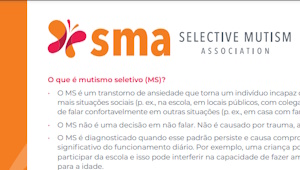Online Library
Myths About Selective Mutism
In the vacuum of inadequate research, it seems that these myths have arisen to fill the void of true knowledge and understanding. Because many of the older theories about selective mutism are currently contributing to the confusion and inappropriate treatment of children with this disorder, this article is an attempt to debunk the following myths.
Myth #1:
Selective mutism (SM) is extremely rare. The most recent study showed a prevalence rate for SM of 7.1 per 1,000 children (or 1/140; Bergman, 2002), and at least twice this rate in multilingual youth (Elizur & Perednik, 2003). Lack of knowledge about selective mutism leads to many of these children being labeled as “just shy” or misdiagnosed as autistic, so the number of cases is likely to be falsely low.
Myth #2:
Children with SM are typically severely emotionally disturbed, usually because they have suffered abuse, neglect or trauma. However, the majority of youth with selective mutism do not indicate a history of a traumatic event, but may have a greater vigilance to threat and danger due to their anxiety. Trauma is not any more likely to be occurring with these children with SM than with the average child (Black & Uhde, 1995; Muris & Ollendick, 2015).
Myth #3:
Children with SM use their silence as a form of passive aggression, manipulation, or defiance. However, despite looking oppositional, selective mutism is more often the result of anxiety, avoidance behavior, and well-learned patterns of removing themselves (or being rescued) from speaking situations to decrease this anxiety.
Myth #4:
Selective mutism is extremely difficult to treat. Evidence suggests significant gains can be made in evidence-based behavioral (and cognitive) treatments in a relatively short amount of time (1 week to 6 months; Bergman et al., 2013, Catchpole et al, 2019; Cornacchio et al., 2019)
Myth #5:
Selective mutism is really just severe shyness; most children will grow out of it. Selective mutism is a diagnosable mental health disorder and shyness is a normal personality trait. Shyness is marked by a tendency to withdraw from people, particularly unfamiliar people, but they are able to function adequately in society. Rather, selective mutism is characterized by extreme inhibition and an inability to adapt to social situations that interferes with a person’s daily functioning and communication with others.
Myth #6:
Selective mutism is a form of autism or is on the autism spectrum. The most obvious distinguishing feature of selective mutism is the selectivity; although autistic children may exhibit symptoms of mutism, the behavior is not variable with situation, environment, or audience. One of the best ways for clinicians to rule out autism is to observe video of the child in his or her comfortable environment (usually in the home) to determine the extent of the lack of speech and a thorough understanding of the child’s true language abilities (recognizing that more broad mutism may be more directly linked to language deficits and autism).
Myth #7:
All children with SM have social anxiety. Although a majority of youth with SM do exhibit symptoms of co-occurring social anxiety disorder, a proportion of children do not show any signs of inhibition, withdrawal, or difficulty engaging with others nonverbally. These are the youth that the teachers describe as running, laughing, playing with other children on the playground, but are just not speaking. It is important to assess all symptoms to determine their presence or absence.
Myth #8:
Children with SM tend to be below average in intelligence. This misperception is probably due to the difficulty educators have in evaluating the abilities of children with SM by traditional verbal methods. Alternative testing methods and use of accommodations such as recordings usually allow for a more accurate assessment for these children.




